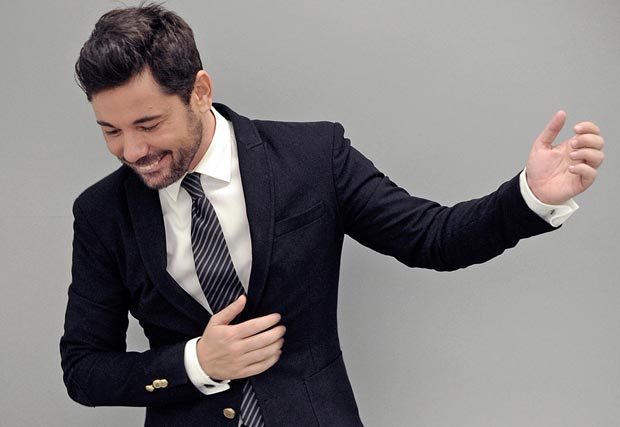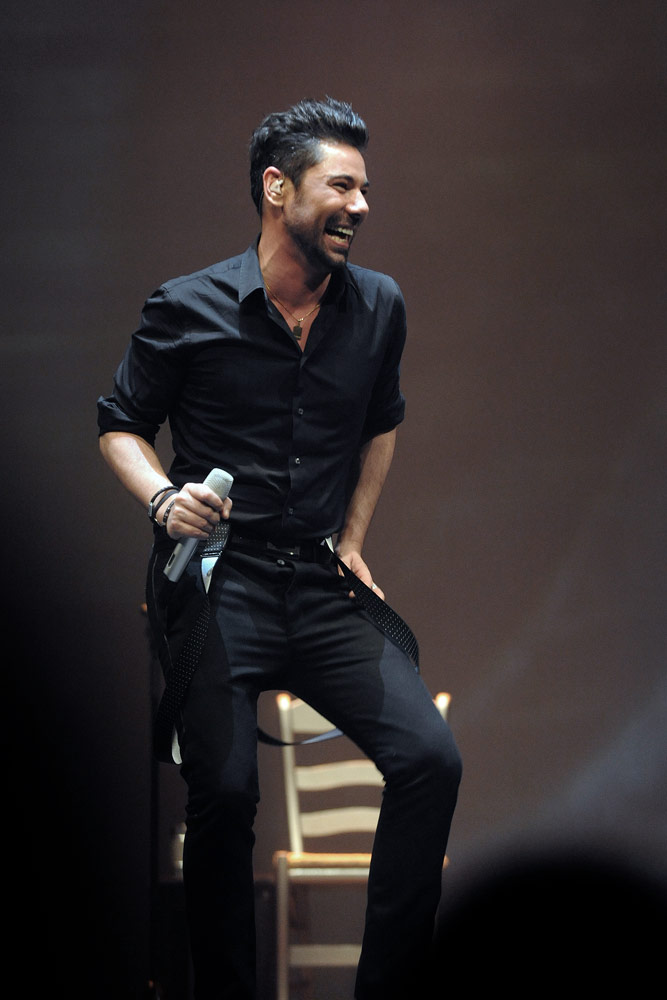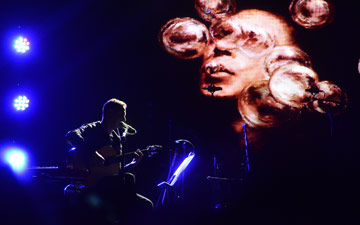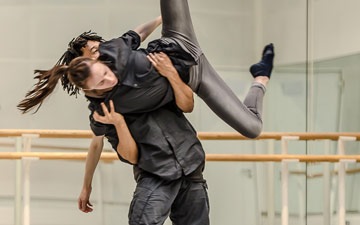
© Maxi del Campo. (Click image for larger version)
Miguel Poveda
In Concert
London, Sadler’s Wells
4 March 2014
www.miguelpoveda.com
www.sadlerswells.com
Miguel Poveda is impossibly boyish for a man who recently passed his 41st birthday, and slim enough to wear a suit with tight-fitting trousers and a buttoned-up jacket that most men of his age could barely get around one arm. Poveda’s youthful charm is further accentuated by a toothy grin, a well groomed beard (let’s call it the nine o’clock shadow), an expressive face and a sizeable quiff of well-gelled, dark hair. Only a guy who really works at it can look this good in his “Philosan*” years.
But the point about Miguel is that he could look like the back end of a bus and people will still flock to see him: because it is to hear him that really matters. The man sings like no-one you will have heard before. To some that might not necessarily be a good thing because his style of flamenco singing is very much a taste that needs to be acquired.
The heartland of flamenco is, of course, in Andalusia, centred around the cities of Seville and Cádiz, a fact that has been heavily emphasised over the past week with the sudden death of one of the greatest flamenco guitarists, Paco de Lucía – who was buried in his home city of Algeciras, near Cádiz, last Saturday, on which day Sara Baras – also from Cádiz – opened the London Festival with La Pepa, a show about the signing of the nineteenth century constitution that established modern Spain……in Cádiz. So, it is perhaps surprising to discover that Poveda – widely regarded as one of the great traditional flamenco singers (cantaores) of this generation – is a Catalan, born in Barcelona. This means a great deal and – as an outsider – it took Poveda much longer to come to the prominence he deserves. It appears that he had to move to Seville (in 2003) in order to be fully embraced within the rather narrow geographical boundaries of the flamenco world.

© Maxi del Campo. (Click image for larger version)
Flamenco is a synthesis of many elements, of which song, guitar, percussion and dance are the fundamental ingredients. In the nuevo flamenco style of Sara Baras, dance tends to be the first among equals but in this concert it is the voice and the guitar that rule. Poveda’s reputation is closely aligned with Juan Gómez ‘Chicuelo’ who – for the most part – sits alongside the cantaor and plays the guitar with extraordinary feeling (a tribute in itself to the great de Lucía). ‘Chicuelo’ is a caricature of an old-style beatnik with a black waistcoat, white shirt, a plentiful mullet of brown hair – severely parted down the middle – and a full dark beard. If someone had told me he came from Liverpool in the early 70s I would have been happily fooled. The concert party was completed by two percussionists (performing largely through hand clapping, or palmas), namely Carlos Grilo and El Londro (the performing identity for Miguel Àngel Soto Peña, who also supplied some rich and gravelly vocals); and by the extraordinary Susana Lupiañez Pinto, otherwise known as La Lupi, a dancer from Málaga steeped in the discipline of traditional flamenco.
La Lupi appeared for just three numbers, wearing for each one a different – yet equally extraordinary – ruched and vividly colourful dress with a long train that she whips around her as part of the performance. She is just two years older than Poveda (a surprise only because of his marked boyishness) and has a formidable reputation in the flamenco world as a teacher as well as a performer: Roció Molina has been one of her pupils as have dancers in Ballet Flamenco Sara Baras. But, on this evidence, La Lupi’s style is in marked contrast to that of Baras and her dancers. Mirrored by the very different costumes they wear, La Lupi is the more flambouyant and earthy, with gestures and movements that border on the bawdy, whereas Baras is more dignified and sensual with a greater economy of effort and discipline in her movement.
La Lupi is the perfect foil for Poveda and, in their final musical number, he also dances a brief duet with her. As dancer and singer, they match each other’s exaggerated, expressive and temperamental style. Both Poveda and La Lupi perform with their hearts worn on their faces. By contrast, the three musicians are positively docile.
Given the difficulties experienced by this boy from Barcelona breaking into the world of flamenco, it must be a foolhardy exercise for a boy from Bedford to try and review such a traditional flamenco concert, especially when I understood perhaps one word in every five hundred in the lyrics. But, there is no mistaking the extreme passion in Poveda’s singing about his love for La Malagueña (the girl from Málaga); or in the luscious Soleá (performed with Grilo) and the exciting Bulería, which united the whole quintet to finish the show. Well, this being flamenco, the show continued on with a deal of talking from the stage and two, if not three, further encores.
Both of the opening shows in this flamenco season have been set to last ninety minutes, without an interval, and yet both have extended to more than two hours. But, I didn’t see any Spanish people (whether from Barcelona or Cádiz) complaining that these particular games had gone into extra time.
(*) For those too young to remember, Philosan was a proprietary tonic advertised on TV in the 1960s & 70s with the strapline “Philosan fortifies the over 40s”.

















You must be logged in to post a comment.